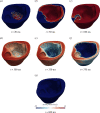Digital twinning of cardiac electrophysiology for congenital heart disease
- PMID: 38835246
- PMCID: PMC11285762
- DOI: 10.1098/rsif.2023.0729
Digital twinning of cardiac electrophysiology for congenital heart disease
Abstract
In recent years, blending mechanistic knowledge with machine learning has had a major impact in digital healthcare. In this work, we introduce a computational pipeline to build certified digital replicas of cardiac electrophysiology in paediatric patients with congenital heart disease. We construct the patient-specific geometry by means of semi-automatic segmentation and meshing tools. We generate a dataset of electrophysiology simulations covering cell-to-organ level model parameters and using rigorous mathematical models based on differential equations. We previously proposed Branched Latent Neural Maps (BLNMs) as an accurate and efficient means to recapitulate complex physical processes in a neural network. Here, we employ BLNMs to encode the parametrized temporal dynamics of in silico 12-lead electrocardiograms (ECGs). BLNMs act as a geometry-specific surrogate model of cardiac function for fast and robust parameter estimation to match clinical ECGs in paediatric patients. Identifiability and trustworthiness of calibrated model parameters are assessed by sensitivity analysis and uncertainty quantification.
Keywords: neural maps; numerical simulations; parameter estimation; single ventricle physiology; uncertainty quantification.
Conflict of interest statement
We declare we have no competing interests.
Figures








Update of
-
Digital twinning of cardiac electrophysiology for congenital heart disease.bioRxiv [Preprint]. 2023 Nov 28:2023.11.27.568942. doi: 10.1101/2023.11.27.568942. bioRxiv. 2023. Update in: J R Soc Interface. 2024 Jun;21(215):20230729. doi: 10.1098/rsif.2023.0729. PMID: 38076810 Free PMC article. Updated. Preprint.
Similar articles
-
Digital twinning of cardiac electrophysiology for congenital heart disease.bioRxiv [Preprint]. 2023 Nov 28:2023.11.27.568942. doi: 10.1101/2023.11.27.568942. bioRxiv. 2023. Update in: J R Soc Interface. 2024 Jun;21(215):20230729. doi: 10.1098/rsif.2023.0729. PMID: 38076810 Free PMC article. Updated. Preprint.
-
Branched Latent Neural Maps.Comput Methods Appl Mech Eng. 2024 Jan;418(Pt A):116499. doi: 10.1016/j.cma.2023.116499. Epub 2023 Oct 9. Comput Methods Appl Mech Eng. 2024. PMID: 37872974 Free PMC article.
-
Whole-heart electromechanical simulations using Latent Neural Ordinary Differential Equations.NPJ Digit Med. 2024 Apr 11;7(1):90. doi: 10.1038/s41746-024-01084-x. NPJ Digit Med. 2024. PMID: 38605089 Free PMC article.
-
Solving the Inverse Problem of Electrocardiography for Cardiac Digital Twins: A Survey.IEEE Rev Biomed Eng. 2025;18:316-336. doi: 10.1109/RBME.2024.3486439. Epub 2025 Jan 28. IEEE Rev Biomed Eng. 2025. PMID: 39453795 Review.
-
Leveraging Preclinical Modeling for Clinical Advancements in Single Ventricle Physiology: Spotlight on the Fontan Circulation.Annu Rev Biomed Eng. 2025 May;27(1):449-472. doi: 10.1146/annurev-bioeng-102723-013709. Epub 2025 Mar 3. Annu Rev Biomed Eng. 2025. PMID: 40030078 Review.
Cited by
-
A universal material model subroutine for soft matter systems.Eng Comput. 2025;41(2):905-927. doi: 10.1007/s00366-024-02031-w. Epub 2024 Sep 18. Eng Comput. 2025. PMID: 40370675 Free PMC article.
-
Artificial Intelligence in Pediatric Electrocardiography: A Comprehensive Review.Children (Basel). 2024 Dec 27;12(1):25. doi: 10.3390/children12010025. Children (Basel). 2024. PMID: 39857856 Free PMC article. Review.
-
The impact of experimental designs & system sloppiness on the personalisation process: A cardiovascular perspective.PLoS One. 2025 Jun 24;20(6):e0326112. doi: 10.1371/journal.pone.0326112. eCollection 2025. PLoS One. 2025. PMID: 40554623 Free PMC article.
-
Digital Twins for Clinical and Operational Decision-Making: Scoping Review.J Med Internet Res. 2025 Jan 8;27:e55015. doi: 10.2196/55015. J Med Internet Res. 2025. PMID: 39778199 Free PMC article.
-
Cardiovascular care with digital twin technology in the era of generative artificial intelligence.Eur Heart J. 2024 Dec 1;45(45):4808-4821. doi: 10.1093/eurheartj/ehae619. Eur Heart J. 2024. PMID: 39322420 Review.
References
-
- Fedele M, Piersanti R, Regazzoni F, Salvador M, Africa PC, Bucelli M, Zingaro A, Dede’ L, Quarteroni A. 2023. A comprehensive and biophysically detailed computational model of the whole human heart electromechanics. Comput. Methods Appl. Mech. Eng. 410, 115983. (10.1016/j.cma.2023.115983) - DOI
-
- Gerach T, et al. . 2021. Electro-mechanical whole-heart digital twins: a fully coupled multi-physics approach. Mathematics 9, 1247. (10.3390/math9111247) - DOI
-
- Peirlinck M, Yao J, Sahli Costabal F, Kuhl E. 2022. How drugs modulate the performance of the human heart. Comput. Mech. 69, 1397–1411. (10.1007/s00466-022-02146-1) - DOI
MeSH terms
Grants and funding
LinkOut - more resources
Full Text Sources
Medical

